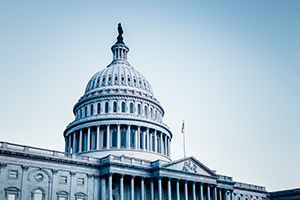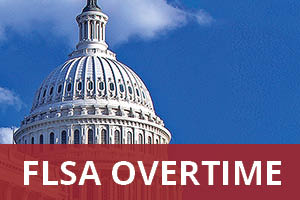by CUPA-HR | December 12, 2023
On December 6, the Biden administration released the Fall 2023 Unified Agenda of Regulatory and Deregulatory Actions, providing the public with an update on the regulatory and deregulatory activities under development across approximately 67 federal departments, agencies and commissions. This release is the second and final regulatory agenda for 2023, and it sets target dates for upcoming regulatory actions mainly for the first half of 2024.
CUPA-HR has highlighted the following items from the Fall 2023 Regulatory Agenda for members to be aware of as we enter the new year. As a reminder, these target dates are not a guarantee, but they provide insight into when we can possibly expect the regulations to be published. CUPA-HR’s government relations team will continue to monitor for any updates on the following regulations and others that may impact the higher education space.
Department of Labor
Wage and Hour Division — Defining and Delimiting the Exemptions for Executive, Administrative, Professional, Outside Sales, and Computer Employees
According to the Fall 2023 Regulatory Agenda, the Department of Labor (DOL)’s Wage and Hour Division (WHD) has targeted April 2024 for release of the final rule to update the Fair Labor Standards Act’s overtime pay regulations. The final rule seeks to increase the minimum salary threshold required for white-collar professionals to maintain exempt status under the FLSA.
On September 8, WHD released a Notice of Proposed Rulemaking (NPRM) to update the salary threshold. The NPRM increases the minimum salary threshold from its current level of $35,568 per year ($684 per week) to $60,209 annually ($1,158 per week), which amounts to a nearly 70% increase.* Additionally, WHD proposes to automatically increase the salary level every three years by tying the threshold to the 35th percentile of full-time salaried wages in the lowest wage census region. DOL indicated in the proposed rule that it is considering implementing an effective date in the final rule that could come as soon as 60 days after the final rule is published to the public.
CUPA-HR was joined by 49 other higher education associations in submitting comments in response to the NPRM. In our comments, we raised concerns with the timing of this increase, the size of the proposed increase, the implementation of automatic updates, and the timeline for regulatory compliance that WHD anticipates. Our comments were informed by a CUPA-HR member survey, in which over 300 members provided feedback on their concerns with and thoughts about the proposal. For ongoing updates, visit CUPA-HR’s FLSA Overtime page.
Wage and Hour Division — Employee or Independent Contractor Classification under the Fair Labor Standards Act
The Fall 2023 Regulatory Agenda indicates that WHD anticipated releasing the FLSA independent contractor rule in November 2023. The final rule has been at the White House Office of Information and Regulatory Affairs (OIRA) for review since September 28, 2023, and once the agency finishes its review, the rule will be published.
On October 13, 2022, the DOL published an NPRM to rescind the current method for determining independent contractor status under the FLSA. The current test, finalized by the Trump administration in 2021, has two core factors of control and investment with three additional factors (integration, skill and permanency) that are relevant only if those core factors are in disagreement. The Biden rule proposes a return to a “totality-of-the-circumstances analysis” of multiple factors in an economic reality test, including the following six factors, which are equally weighted with no core provisions:
- The extent to which the work is integral to the employer’s business.
- The worker’s opportunity for profit or loss depending on managerial skill.
- The investments made by the worker and the employer.
- The worker’s use of skill and initiative.
- The permanency of the work relationship.
- The degree of control exercised or retained by the employer.
Employment and Training Administration — Revising Schedule A to Include Updating Occupations in Science, Technology, Engineering, and Mathematics (STEM)
The regulatory agenda indicates that DOL’s Employment and Training Administration (ETA) aimed to issue a Request for Information (RFI) in November 2023. According to the notice in the agenda, ETA is seeking input from the public “on whether Schedule A serves as an effective tool for addressing current labor shortages, and how the Department may create a timely, coherent and transparent methodology for identifying STEM occupations that are experiencing labor shortages in keeping with its requirements under the Immigration and Nationality Act … to ensure the employment of foreign nationals does not displace U.S. workers or adversely affect their wages and working conditions.”
The RFI was sent to OIRA for review before publication on November 11, 2023, and will likely be released to the public soon.
Equal Employment Opportunity Commission
Regulations to Implement the Pregnant Workers Fairness Act
In December 2023, the Equal Employment Opportunity Commission (EEOC) plans to issue a final rule to implement the Pregnant Workers Fairness Act (PWFA). The rule will create a framework for the EEOC on how to enforce protections granted to pregnant workers under the PWFA. For a detailed analysis of the proposed rule on implementing the PWFA, please see CUPA-HR’s blog post.
In December 2022, the PWFA was signed into law through the Consolidated Appropriations Act of 2023. The law establishes employer obligations to provide reasonable accommodations to pregnant employees so long as such accommodations do not cause an undue hardship on the business, and makes it unlawful to take adverse action against a qualified employee requesting or using such reasonable accommodations. The requirements of the law apply only to businesses with 15 or more employees.
Unlike the other regulations with target dates, the PWFA final rule has a statutory deadline for publication, which is December 29, 2023. Given this upcoming deadline, we will likely see the EEOC publish this rule soon.
Department of Education
Office for Civil Rights — Nondiscrimination on the Basis of Sex in Education Programs or Activities Receiving Federal Financial Assistance
According to the regulatory agenda, the Department of Education (ED) anticipates releasing the highly anticipated Title IX final rule in March 2024. The rulemaking would finalize the June 2022 NPRM to roll back and replace the Trump administration’s 2020 regulations while simultaneously expanding protections against sex-based discrimination to cover sexual orientation, gender identity, and pregnancy or related conditions.
CUPA-HR filed comments in September 2022 in response to the NPRM. In our comments, we brought attention to the possible impact the proposed regulations could have on how higher education institutions address employment discrimination.
The new March target deadline marks the third time ED has delayed the issuance of the Title IX final rule. The rule was originally targeted for release in May 2023, but ED subsequently pushed the target date back to October 2023 via a blog post, when it became clear that the department would not meet the May timeline. Since ED missed the October timeline, they have faced increased pressure from Congressional Democrats and other advocacy groups to publish the final rule as soon as possible. While it’s not a guarantee ED will be able to publish the final rule in March 2024, the increased pressure will certainly motivate the department to move quickly.
CUPA-HR plans to hold a webinar to inform members of the final rule’s new requirements once the final rule has been published. Details to come.
Office for Civil Rights — Nondiscrimination on the Basis of Sex in Education Programs or Activities Receiving Federal Financial Assistance: Sex-Related Eligibility Criteria for Male and Female Athletic Teams
Similar to the Title IX final rule above, ED plans to issue a final rule on student eligibility in athletic programs under Title IX in March 2024. The rule would finalize the NPRM that was released by the department in April 2023.
Under the NPRM, schools that receive federal funding would not be permitted to adopt or apply a “one-size-fits-all” ban on transgender students participating on teams consistent with their gender identity. Instead, the proposal allows schools the flexibility to develop team eligibility criteria that serve important educational objectives, such as fairness in competition and preventing sports-related injuries. The department further explains that the eligibility criteria must take into account the sport, level of competition, and grade or education level of students participating, and the criteria would have to minimize harm to students whose opportunity to participate on a team consistent with their gender identity would be limited or denied.
The NPRM received over 150,000 comments addressing support for and concerns with the proposal. ED must review all comments before issuing a final rule to implement these regulations, which is the likely cause of delay for both this rulemaking and the broader Title IX final rule.
Department of Homeland Security
U.S. Citizenship and Immigration Services — Modernizing H-1B Requirements and Oversight and Providing Flexibility in the F-1 Program
On October 23, the Department of Homeland Security’s U.S. Citizenship and Immigration Services (USCIS) issued a proposed rule that aims to improve the H-1B program by simplifying the application process, increasing the program’s efficiency, offering more advantages and flexibilities to both petitioners and beneficiaries, and strengthening the program’s integrity measures.
Prompted by challenges with the H-1B visa lottery, USCIS has prioritized a proposed rule to address the system’s integrity. The proposed rule is aimed at strengthening the lottery registration process and preventing fraud, and it makes critical revisions to underlying H-1B regulations. For a detailed summary of what the H-1B proposal includes, see CUPA-HR’s blog post.
The NPRM is open for public comment until December 22, 2023. The Fall 2023 Regulatory Agenda included the regulations, but it did not provide a timeline for issuing the final rule, likely because the comment period is still open for the NPRM.
U.S. Citizenship and Immigration Services — Fee Schedule and Changes to Certain Other Immigration Benefit Request Requirements
In April 2024, USCIS anticipates issuing a final rule to adjust the fees charged by the agency for immigration and naturalization benefit requests.
USCIS published an NPRM on this issue in January 2023. The comprehensive proposal has implications for both employment-based and family-based filings, but certain provisions would have significant impacts for higher education employers. Specifically, the proposed rule includes a provision to fund the Asylum Program with employer petition fees, which would be a $600 fee paid by any employers who file either a Form I-129, Petition for a Nonimmigrant Worker, or Form I-140, Immigrant Petition for Alien Worker. Additionally, the proposed rule seeks to increase almost all employment-based and employment-based “adjacent” filing fees. For more information on the details of this proposed rule, see CUPA-HR’s blog post.
On March 13, 2023, CUPA-HR joined the American Council on Education’s comments in response to the NPRM. The comments address higher ed-specific concerns with the proposal to increase fees for immigration and naturalization benefit requests, including concerns about the impact the increased fees will have on international scholars and institutions’ ability to hire nonimmigrant workers, including H-1B workers.
U.S. Citizenship and Immigration Services — Petition for Immigrant Worker Reforms
The regulatory agenda shows that USCIS plans to issue an NPRM in August 2024 that will “amend its regulations governing employment-based immigrant petitions in the first, second and third preference classifications.” According to the posting, the proposed rule would “codify current policy guidance and implement administrative decisions regarding successorship-in-interest and ability to pay; update provisions governing extraordinary ability and outstanding professors and researchers; modernize outdated provisions for individuals of extraordinary ability and outstanding professors and researchers; … implement reforms to ensure the integrity of the I-140 program; and correct errors and omissions.”
U.S. Citizenship and Immigration Services — Modernizing Regulations Governing Nonimmigrant Workers
In October 2024, USCIS plans to issue an NPRM to update employment authorization rules for dependent spouses of certain nonimmigrants and to increase flexibilities for nonimmigrant workers. CUPA-HR plans to monitor for any updates to this rule as it may apply to H-1B or other relevant nonimmigrant visas used by institutions.
Department of State
Pilot Program to Resume Renewal of H-1B Nonimmigrant Visas in the United States for Certain Qualified Noncitizens
In February 2024, the Department of State plans to begin a pilot program to “resume domestic visa renewal for qualified H-1B nonimmigrant visa applicants who meet certain requirements.” The department will issue a notice in the Federal Register that will describe pilot program participation requirements and will provide “information on how those falling within the bounds of the pilot program may apply for domestic visa renewal.” The pilot program has been at OIRA since October 17, meaning the pilot notice could be published sooner than anticipated.
* The discrepancy between our figure of $60,209 and the DOL’s preamble figure of $55,068 arises from DOL’s own projections based on anticipated wage growth. The DOL’s proposed rule is rooted in 2022 data (yielding the $55,068 figure), but a footnote in the NPRM confirms that the salary threshold will definitely change by the time the final rule is issued to reflect the most recent data. Our comments, aiming to respond to the most probable salary threshold at the time a final rule is released, references the DOL’s projected figure for Q1 2024, which is $60,209. We do not believe DOL will be able to issue a final rule before Q1 2024, so we are incorporating this projected figure into our response to the NPRM. In essence, our goal is to provide members with a clearer picture of the likely salary figure when the final rule comes into play.
Share This Article:




